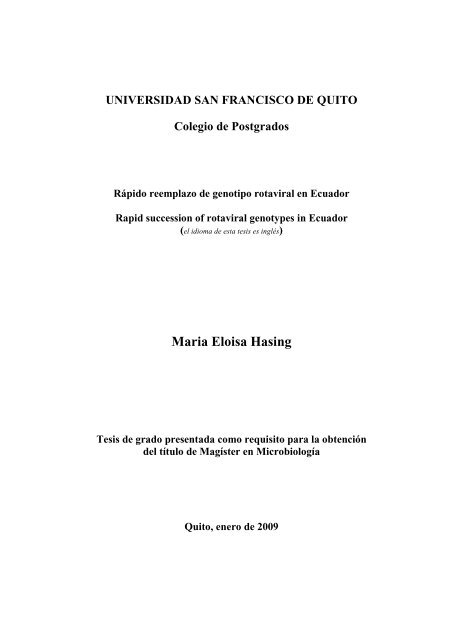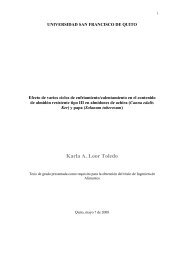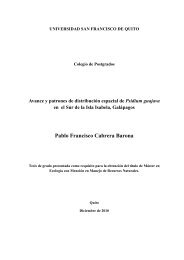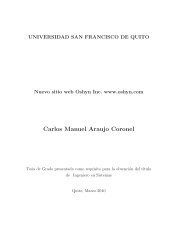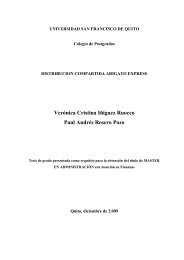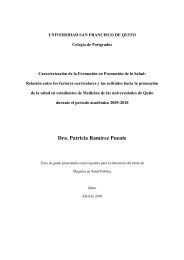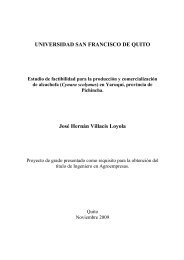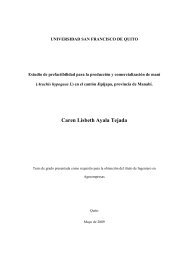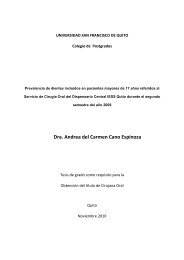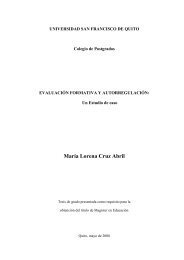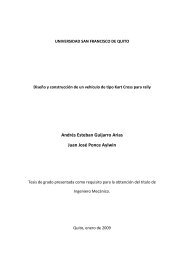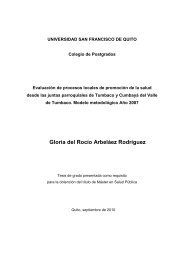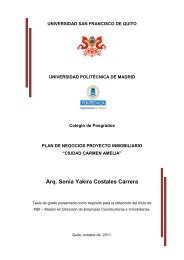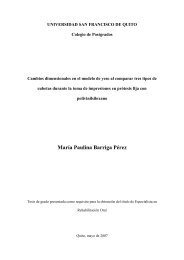Maria Eloisa Hasing - Repositorio Digital USFQ - Universidad San ...
Maria Eloisa Hasing - Repositorio Digital USFQ - Universidad San ...
Maria Eloisa Hasing - Repositorio Digital USFQ - Universidad San ...
Create successful ePaper yourself
Turn your PDF publications into a flip-book with our unique Google optimized e-Paper software.
UNIVERSIDAD SAN FRANCISCO DE QUITO<br />
Colegio de Postgrados<br />
Rápido reemplazo de genotipo rotaviral en Ecuador<br />
Rapid succession of rotaviral genotypes in Ecuador<br />
(el idioma de esta tesis es inglés)<br />
<strong>Maria</strong> <strong>Eloisa</strong> <strong>Hasing</strong><br />
Tesis de grado presentada como requisito para la obtención<br />
del título de Magíster en Microbiología<br />
Quito, enero de 2009
UNIVERSIDAD SAN FRANCISCO DE QUITO<br />
Colegio de Postgrados<br />
HOJA DE APROBACION DE TESIS<br />
Rápido reemplazo de genotipo rotaviral en Ecuador<br />
Rapid succession of rotaviral genotypes in Ecuador<br />
(el idioma de esta tesis es inglés)<br />
Gabriel Trueba, Ph.D.<br />
Director de la Maestría en<br />
Microbiología y<br />
Director de Tesis<br />
Manuel Baldeón, Ph.D.<br />
Miembro del Comité del Tesis<br />
Marco Fornasini, Ph.D.<br />
Miembro del Comité del Tesis<br />
Stella de la Torre, Ph.D.<br />
Decana del Colegio de Ciencias<br />
Biológicas y Ambientales<br />
Víctor Viteri Breedy, Ph.D.<br />
Decano del Colegio de<br />
Postgrados<br />
<strong>Maria</strong> <strong>Eloisa</strong> <strong>Hasing</strong><br />
.....................................................................<br />
.....................................................................<br />
.....................................................................<br />
.....................................................................<br />
.....................................................................<br />
Quito, enero de 2009
© Derechos de autor<br />
<strong>Maria</strong> <strong>Eloisa</strong> <strong>Hasing</strong> Rodriguez<br />
2009<br />
iii
A Rafael y Ricardo<br />
iv
Acknowledgments<br />
I thank the ECODESS field team, Karina Ponce and William Cevallos for their work in<br />
collecting data; I also thank Pablo Endara and Owen Solberg for their helpful<br />
recommendations during laboratory work, and Gabriel Trueba, Joseph Eisenberg, Manuel<br />
Baldeón and Marco Fornasini for the manuscript revision and valuable comments.<br />
v
Resumen<br />
Un estudio previo indicó que G9P[8] fue el genotipo de rotavirus más prevalente en 22<br />
comunidades rurales de Esmeraldas y un hospital urbano de Quito, Ecuador durante<br />
febrero 2005- febrero 2006. El objetivo del presente estudio fue caracterizar los genotipos<br />
rotavirales que circularon las mismas áreas rurales durante los años 2006-2007, y el mismo<br />
hospital urbano durante el año 2007. En total 990 muestras de heces fueron recolectadas<br />
en las áreas rurales, de las cuales 84 (74 casos y 14 controles) fueron rotavirus positivas a<br />
un test inmunocromatográfico. La genotipificación mediante RT-PCR de todas las<br />
muestras positivas demostró que durante 2006 el genotipo más común fue G9 (22%);<br />
mientras que en 2007 fue G2 (34%). Las muestras del hospital urbano también<br />
demostraron un predominio de G2 (53%) vs. G9 (27%). Tanto en las muestras urbanas<br />
como rurales G2 se encontró asociado principalmente con P[4]. Una proporción<br />
considerable de muestras rurales (58%) no pudieron ser genotipificadas, posiblemente<br />
como consecuencia de una gran variabilidad genética del virus en esta zona. El rápido<br />
reemplazo de G9 por G2 y la gran cantidad de aislados rurales no genotipificados refuerza<br />
la necesidad de establecer sistemas de vigilancia que provean información precisa a<br />
programas de vacunación contra rotavirus.<br />
vi
Abstract<br />
A previous study indicated that G9P[8] was the most prevalent rotavirus genotype in 22<br />
rural communities of Esmeraldas and an urban hospital in Quito, Ecuador during February<br />
2005- February 2006. The objective of the present study was to characterize the rotavirus<br />
genotypes that circulated the same rural areas during the years 2006 - 2007 and the same<br />
urban hospital during the year 2007. A total of 990 stool samples were collected in the<br />
rural areas, of which 84 (70 from cases and 14 from controls) were rotavirus positive by an<br />
immunochromatographic test. Genotyping of all rotavirus positive samples by RT-PCR<br />
showed that the most common typeable genotype was G9 (22%) in 2006, but G2 (34%) in<br />
the following year. The samples from the urban hospital also showed a predominance of<br />
G2 (53%) vs. G9 (27%). In the urban as well as the rural samples, G2 was mainly<br />
associated to P[4]. A large number of rural samples (58%) could not be genotyped,<br />
possibly as consequence of a high genetic variability of the virus in that area. The sudden<br />
replacement of G9 by G2 and the high number of rural untypeable isolates reinforces the<br />
necessity of establishing surveillance programs to supply accurate information to<br />
vaccination programs against rotavirus.<br />
vii
Table of contents<br />
1. Introduction ..................................................................................................... 10<br />
2. Materials and Methods .................................................................................... 12<br />
2.1. Study Population and Design ................................................................... 12<br />
2.2. Detection of Rotavirus and RNA extraction ............................................. 12<br />
2.3. RT-PCR and Multiplex-PCR for rotavirus genotyping ............................ 12<br />
2.4. Statistical analysis ..................................................................................... 13<br />
3. Results ............................................................................................................. 14<br />
4. Discussion ........................................................................................................ 17<br />
5. References ....................................................................................................... 21<br />
viii
List of figures<br />
Table 1. Number of rotavirus positive samples by age group ................................... 14<br />
Table 2. Rotavirus Genotype Combinations detected in stool samples from the rural<br />
coastal communities and the children hospital in Quito between 2006 and 2007 ............... 15<br />
Table 3. Rotavirus Genotype Combinations detected in stool samples from the rural<br />
coastal communities between 2006 and 2007 on cases and controls .................................. 16<br />
Figure 1. Comparation of percent isolates identified in the rural communities of<br />
Esmeraldas and Quito as genotype G2, G9 by year ............................................................ 19<br />
ix
1. Introduction<br />
Rotavirus is the main diarrhea causing agent responsible for 454,000-705,000 children<br />
deaths each year worldwide (1). The virus belongs to the Reoviridae family; it has a three<br />
layered capsid that surrounds a genome made of 11 segments of double stranded RNA.<br />
The middle capsid layer is composed of the VP6 protein which is the most abundant<br />
protein of the virus and permits classification into groups A to E based on the presence of<br />
specific epitopes. Most human infecting rotaviruses belong to group A (2).<br />
Proteins VP7 and VP4, also named G and P respectively, conform the outermost layer of<br />
the capsid. Both proteins are neutralizing immunogens, and the nucleotide sequences of<br />
the corresponding genes are utilized for typing purposes The Rotavirus Classification<br />
Working Group has catalogued 19 VP7 genotypes and 27 VP4 genotypes (3), and a novel<br />
genotype (G20P[28]) was recently described in Ecuador (4). Globally, G1, G2, G3, G4,<br />
and G9 are the most predominant genotypes of VP7, whereas P[8], P[4], P[6]and P[9] are<br />
the most prevalent of VP4 (5, 6). There are uncommon genotypes like G5, G6, G8, and<br />
G10 that are endemic in certain communities in Brazil, Australia, Malawi, and India<br />
respectively (5, 6).<br />
Rotavirus has a large intra and inter genotype diversity because of genetic reassortments,<br />
point mutations, genomic rearrangement, and genetic recombination (5, 7). This diversity<br />
constitutes an important problem for the design of effective vaccines to decrease rotavirus<br />
associated mortality and morbidity. Although available rotaviral vaccines have shown to<br />
protect against severe gastroenteritis caused by genotypes G1, G2, G3, G4 and G9 (8, 9), it<br />
is still uncertain the degree of cross protection against genotypes not present in vaccines (9,<br />
10, 11).<br />
10
A previous study on rotavirus genotype prevalence conducted recently in Ecuador showed<br />
that G9 was the most prevalent rotavirus genotype circulating in 22 rural communities of<br />
Esmeraldas and a children’s hospital in Quito during February 2005-February 2006 (12).<br />
The present study constitutes a follow up study of the previous one and therefore covered<br />
the same areas during the next two subsequent years (2006 and 2007). Differently from<br />
most studies of rotavirus genotype prevalence, which are based on hospital samples, the<br />
results from the rural settings obtained in this study are community based and included<br />
both asymptomatic and symptomatic patients. The hospital samples from a distant urban<br />
location, Quito, were used as an indicator of the representativity of the results obtained in<br />
rural areas.<br />
11
2. Materials and Methods<br />
2.1. Study Population and Design<br />
All protocols have been described elsewhere (12). Briefly, twenty-two rural communities<br />
located in the northern coast of Ecuador, were visited two times for 15 days, first between<br />
May and December, 2006, and the second time between January and July, 2007. Each<br />
household was visited in order to capture all cases of diarrhea. For each case of diarrhea,<br />
three additional stool specimens were randomly collected from controls, one from the<br />
patient household and two randomly selected from the same community. Cases were<br />
defined as individuals with three or more loose stools in a 24h period and controls as<br />
individuals with no diarrhea within the past 6 days. Rotavirus positive fecal samples from<br />
the Hospital de Niños Baca Ortiz in Quito were also collected between January 2007 and<br />
May 2007 for PCR genotyping. All protocols were approved by the IRB committees of the<br />
University of Michigan and <strong>Universidad</strong> <strong>San</strong> Francisco de Quito.<br />
2.2. Detection of Rotavirus and RNA extraction<br />
All fecal samples were tested for rotavirus with the RIDA Quick Rotavirus<br />
immunochromatographic test (R-Biopharm AG, Darmstadt, Germany), stored in liquid<br />
nitrogen, and sent to Quito for PCR-genotyping. RNA from all rotavirus positive samples<br />
was extracted with the kit QIAamp Viral RNA Mini kit (Qiagen, Germany) and RNA was<br />
stored at -80°C for further analysis (12).<br />
2.3. RT-PCR and Multiplex-PCR for rotavirus genotyping<br />
Rotavirus genotypes were determined with a two step seminested multiplex reverse<br />
transcription PCR as described elsewhere (12). After viral RNA was denatured at 97°C for<br />
12
5 min., retro-transcription and first amplification were carried out using SuperScript III<br />
RT/Platinum Taq polymerase kit (Invitrogen Corp.). Primers were added to a final<br />
concentration of 267nM each, 9Con1 (forward) and 9Con2 (reverse) for the VP7<br />
amplification (13) or Con3 (forward) and Con2 (reverse) for the VP4 amplification (14).<br />
Retro-transcription was carried out at 42°C for 45 min and stopped at 96°C for 2 min.<br />
First amplification cycling parameters were 30 cycles at 94°C for 30s, 50°C for 30s, and<br />
72°C for 60s.<br />
Genotypes G and P were determined in a second amplification by using PuReTaq Ready-<br />
To-Go PCR beads (Amersham Biosciences, Piscataway, NJ, USA) and primers at a final<br />
concentration of 400nM. For G genotyping, primer 9Con1 and reverse primers 9T-1, 9T-<br />
2, 9T-3P, 9T-4 and 9T-9B (13) were used. Primer Con3 and reverse primers 1T-1, 2T1,<br />
3T-1, 4T-1, 5T-1 y ND3 (14) were used for P genotyping. The cycling parameters were 30<br />
cycles at 94°C for 30s, 42°C for 30s, and 72°C for 60s and final extension at 72°C for 1<br />
min. The amplicons of the second amplification were run on a 2% agarose electrophoresis<br />
gel and bands were visualized by ethidium bromide staining.<br />
2.4. Statistical analysis<br />
Descriptive statistics were used to present all results. Means were calculated for continuos<br />
variables and percentages were calculated for categorical variables. In order to compare<br />
differences in rotavirus presence among cases and controls, the odds ratio was calculated<br />
along with its 95% confidence interval which was calculated through Fisher’s chi square<br />
test. P values ≤ 0.05 were considered statistically significant.<br />
13
3. Results<br />
A total of 990 stool samples were collected in two visits to 22 rural communities of the<br />
northern coast of Ecuador, 281 (28.4%) of these samples were from patients with diarrhea<br />
and 709 (71.6%) from asymptomatic controls. The immunochromatographic test showed<br />
that 84 (8.5%) samples were rotavirus positive, of which 70 (7.1%) were from patients<br />
with diarrhea while the remaining 14 (1.4%) samples were from asymptomatic controls.<br />
The presence of diarrhea was significantly associated with rotavirus infection (odds<br />
ratio=16.5; 95% confidence interval 8.9 to 32.2) (Table 1). Rotavirus prevalence on a 15<br />
day period had the highest value (9.8 %) for children under one year of age (Table 1).<br />
Table 1. Number of rotavirus positive samples by age group<br />
Prevalence*<br />
*(%)<br />
2,7 9,8 2,3 0,4 0,3 0,4 1,0<br />
+ indicates number of rotavirus positive samples with the immunochromatographic test. OR, odds<br />
ratio; CI, confidence interval. The CI was calculated using the Fisher exact test.<br />
*Not significative (P>0.05).<br />
Age group<br />
Missing<br />
birthdates<br />
in samples from 2007, G2 was the most prevalent typeable genotype representing 34% of<br />
all rotavirus positive samples, followed by G9, which accounted for 7%. In all community<br />
samples there was no evidence of mixed genotype infection, but two hospital samples<br />
showed two different G or P types in the same sample. The most frequent G and P<br />
combinations detected in this study were, G2P[4] and G9P[8]. A separated analysis of<br />
control and case-patient samples shows that the most prevalente genotypes, that is G2, G9<br />
and the combinations G2P[4] and G9P[8], were detected in controls as well as case-patient<br />
(Table 3).<br />
Table 2. Rotavirus Genotype Combinations detected in stool samples from the rural<br />
coastal communities and the children hospital in Quito between 2006 and 2007<br />
Number of strains detected (%)<br />
Coastal communities Quito<br />
Genotype 2006, first visit 2007, second visit 2007<br />
G1 PNT 3(5,6) - -<br />
G2 PNT 1(1,9) 1(3,4) 1(3,3)<br />
G9 PNT 10(18,5) - 1(3,3)<br />
GNT P[4] 1(1,9) - -<br />
G1 P[6] 1(1,9) - -<br />
G3 P[6] 1(1,9) - -<br />
G9 P[4] 1(1,9) - -<br />
G9 P[8] 1(1,9) 2(6,9) 8(26,7)<br />
G2 P[4] 3(5,6) 9(31,0) 16(53,3)<br />
G4 P[6] - - 2(6,7)<br />
G20 P[28] 1(1,9) - -<br />
G9 P[8]/P[6] - - 1(3,3)<br />
G4/G9 P[6] - - 1(3,3)<br />
GNT PNT 31(57,4) 17(58,6) -<br />
TOTAL 54 29 30<br />
NT = not typeable<br />
A subset of 30 samples randomly selected form 102 rotaviral positive samples collected<br />
from children at the Hospital de Niños Baca Ortiz in 2007, was genotyped by RT-PCR.<br />
Most of the samples (28 out of 30) were successfully genotyped for both genes; two<br />
15
samples could not be genotyped for the P segment. The predominant genotype was<br />
G2P[4] accounting for 53,3% of all samples while G9P[8] occurred in 26,7% of the<br />
samples. Two cases of mixed infections were found among the hospital samples (Table 2).<br />
Table 3. Rotavirus Genotype Combinations detected in stool samples from the rural<br />
coastal communities between 2006 and 2007 on cases and controls<br />
Number of strains detected<br />
Genotype Cases (%) Controls (%)<br />
G1 PNT 3(4,3) -<br />
G2 PNT 1(1,4) 1(7,1)<br />
G9 PNT 8(11,4) 2(14,3)<br />
GNT P[4] 1(1,4) -<br />
G1 P[6] 1(1,4) -<br />
G3 P[6] 1(1,4) -<br />
G9 P[4] 1(1,4) -<br />
G9 P[8] 2(2,9) 1(7,1)<br />
G2 P[4] 11(15,7) 1(7,1)<br />
G20 P[28] 1(1,4) -<br />
GNT PNT 40(57,1) 9(64,3)<br />
TOTAL 70(100) 14(100)<br />
16
4. Discussion<br />
The present results show evidence of an abrupt replacement of genotype G9 with G2 in<br />
two different regions of Ecuador within a two year period. According to a previous study<br />
carried out in the same locations during 2005-2006 (12), the most prevalent genotype<br />
detected in the rural communities and Quito, was G9 with proportions of 72% and 90%<br />
respectively, while G2 was not found in the 22 rural communities and was a minor<br />
genotype in samples from the urban hospital. A more recent study carried out in Ecuador<br />
by Naranjo et al., reported that during 2006 G9 was the most prevalent genotype found in<br />
10 different provinces of Ecuador (Azuay, Cotopaxi, Chimborazo, Imbabura, Pichincha,<br />
Esmeraldas, Guayas, Manabí, Napo and Pastaza) followed by G2 which was found in<br />
approximately 28% of the samples. (15). In the present study it was shown that G2<br />
infection went from 7% in 2006 to 34% in 2007 within the rural settings, and it reached<br />
57% in the urban hospital during 2007. Along with this rise on G2 prevalence, a decrease<br />
of G9 was observed also at both locations.<br />
Other studies have also shown that the prevalent rotavirus genotypes circulating within a<br />
population change in short periods of time (16, 17). In Chiang Mai, Thailand, during the<br />
years 2000-2001, the most prevalent genotype was G9; by the year 2003, G2 emerged as<br />
the prevailing genotype but only to decline again in 2004, when G1 became the most<br />
common (16). In Bangladesh a change of the prevailing genotypes, similar to the change<br />
reported in this study, has also been observed: between years 2001 and 2005 the prevailing<br />
strains belonged to genotypes G1P[8] and G9P[8], however by the 2005-2006 season<br />
G2P[4] became predominant (17)<br />
17
Changes in the pattern of prevailing viral genotypes within a population may be explained<br />
by the interplay between population’s immunity and viral evolution. The presence of<br />
antibodies against a serotype of rotavirus prevent re-infections by the antigenically related<br />
viruses but may not against other distinct serotypes (2, 5, 10, 18). The population may<br />
build up immunity reducing the circulation of G9 and allowing antigenically distinct<br />
serotypes to infect. Additionally, viral variants possessing greater infective aptitudes may<br />
emerge only to disappear when populations reach a certain level of herd immunity (19).<br />
The large proportion of samples from rural communities that could not be genotyped<br />
constitutes a limitation of this study. Many studies of rotavirus surveillance have reported<br />
different rates of genotyping failure e.g. 16% in Western Africa (20), ≤2% in Denmark and<br />
Malawi (21, 22), 0% in Bangladesh and Thailand (16, 17). In Ecuador, Naranjo et al and<br />
Endara et al report a similar rate of genotyping failure (18% and 17% respectively) (12,<br />
15)<br />
The increased rate of genotyping failure observed within rural communities could be due<br />
the presence of unusual strains, which often occur in developing countries and they are<br />
likely to infect humans due to contact with animals (5, 6). These zoonotic infections<br />
promote the emergence of new genotypes by viral reassortment. The presence of unusual<br />
genotypes may explain the greater abundance of what appeared to be untypeable virus in<br />
samples from rural communities when compared with samples from urban setting. An<br />
evidence that supports this theory is that one of the isolates found during this study was a<br />
rotavirus with novel G and P types (4). This would suggest that before 2007 the G9<br />
genotype was able to temporarily supplant indigenous novel strains, explaining the higher<br />
proportion of isolates that could be typed during 2005 (Figure 1).<br />
18
Figure 1. Comparation of percent isolates identified in the rural communities of<br />
Esmeraldas and Quito as genotype G2, G9 by year<br />
A<br />
B<br />
80%<br />
70%<br />
60%<br />
50%<br />
40%<br />
30%<br />
20%<br />
10%<br />
0%<br />
90%<br />
80%<br />
70%<br />
60%<br />
50%<br />
40%<br />
30%<br />
20%<br />
10%<br />
0%<br />
G2 G9 NT Other<br />
G2 G9 NT Other<br />
White: 2005, grey: 2006, black: 2007. A) Esmeraldas; B) Quito. NT designates undetermined<br />
types. 'Other' includes genotypes G1, G3, and G4. The data from 2005 was taken from Endara et<br />
al, 2007 (12)<br />
Other causes of genotyping failure may be sample degradation, the presence of false<br />
positive results in the immunochromatographic test, primer-template mismatch because of<br />
minor sequence variations (23; 24; 25) or primer competition during nested PCR (26).<br />
19
However these explanations are undermined by two facts: first, stability tests conducted<br />
with fecal samples (4) and a previous study (27) suggesting that rotaviral particles are very<br />
stable and; second, genotyping failure was observed almost exclusively in the rural<br />
samples thus, if the problem was the procedure then a similar percentage of genotyping<br />
failure would have been found among urban samples as well.<br />
The impact that vaccination programs may have on this study is none or not significant<br />
because a vaccine against rotavirus have been administrated freely in Ecuador only after<br />
July 2007 (28) and by this time all the samples analyzed in this study were already<br />
collected. Before July 2007 vaccines were offered in the country but only by pediatricians<br />
on private consultation and at a relatively expensive price (29).<br />
To date, no rotaviral vaccine has proved to be adequately effective against G and P protein<br />
types not present their formulations. The sudden change of G9 by G2 found in this study,<br />
and the presence of a considerable high number of untypeable strains in rural areas<br />
reinforce the need to establish permanent rotaviral surveillance studies to give accurate<br />
information to vaccination programs.<br />
20
5. References<br />
1. Parashar UD, Gibson CJ, Bresee JS, Glass RI. Rotavirus and severe childhood diarrea.<br />
Emerg Infect Dis. 2006 Feb;12(2):304-6.<br />
2. Estes MK, Kapikian AZ. Rotaviruses. In: Knipe DM, Howley PM, Griffin DE, Lamb<br />
RA, Martin MA, editors. Fields Virology. Philadelphia: Lippincott Williams &<br />
Wilkins; 2007. p 1917-74.<br />
3. Matthijnssens J, Ciarlet M, Rahman M, Attoui H, Banyai K, Estes MK, et al.<br />
Recommendations for the classification of group A rotaviruses using all 11 genomic<br />
RNA segments. Arch Virol. 2008 Aug;153(8):1621-9.<br />
4. Solberg O, <strong>Hasing</strong> M, Trueba G, Eisenberg J. Characterization of novel VP4, VP6, and<br />
VP7 genotypes of a previously untypeable group A rotavirus. Virol J. In Press 2008.<br />
5. Gentsch JR, Laird AR, Bielfelt B, Griffin DD, Bányai K, Ramachandran et al.<br />
Serotype diversity and reassortment between human and animal rotavirus strains:<br />
Implications for Rotavirus Vaccine Programs. J Infect Dis. 2005 Sep;192 Suppl 1:S46-<br />
59.<br />
6. <strong>San</strong>tos N, Hoshino Y, Global distribution of rotavirus serotypes/genotypes and its<br />
implication for the development and implementation of an effective rotavirus vaccine.<br />
Rev. Med. Virol. 2005 Jan;15:29-56<br />
7. Phan TG, Okitsu S, Maneekarn N, Ushijima H. Evidence of intragenic recombination<br />
in G1 rotavirus VP7 genes. J Virol. 2007 Sep;81(18):10188-94.<br />
21
8. Vesikari T, Matson DO, Dennehy P, Damme PV, <strong>San</strong>tosham M, Rodriguez Z, et al.<br />
Safety and efficacy of a pentavalent human-bovine (WC3) reassortant rotavirus<br />
vaccine. N Engl J Med. 2006 Jan;354(1):23-33.<br />
9. Ruiz-Palacios GM, Pérez-Schael I, Velázquez R, Abate H, Breuer T, Costa SA, et al.<br />
Safety and efficacy of an attenuated vaccine against severe rotavirus gastoenteritis. N<br />
Engl J Med. 2006 Jan;354(1):11-22.<br />
10. Bernstein DI. Live Attenuated human rotavirus vaccine, Rotarix. Semin Pediatr Infect<br />
Dis. 2006 Oct;17(4):188-94.<br />
11. Gurgel RQ, Cuevas LE, Vieira SC, Barros VC, Fontes PB, Salustino EF et al.<br />
Predominance of rotavirus P[4]G2 in a vaccinated population, Brazil. Emerg Infect<br />
Dis. 2007 Oct;13(10):1571-3.<br />
12. Endara P, Trueba G, Solberg O, Bates SJ, Karina P, Cevallos W, et al. Symptomatic<br />
and subclinical infection with rotavirus P[8]G9, rural Ecuador. Emerg Infect Dis. 2007<br />
Apr;13(4):574-9.<br />
13. Das BK, Gentsch JR, Cicirello HG, Woods PA, Gupta A, Ramachandran M, et al.<br />
Characterization of rotavirus strains from newborns in New Delhi, India. J Clin<br />
Microbiol. 1994 Jul;32(7):1820-2.<br />
14. Gentsch JR, Glass RI, Woods P, Gouvea V, Gorziglia M, Flores J, et al. Identification<br />
of group A rotavirus gene 4 types by polymerase chain reaction. J Clin Microbiol.<br />
1992 Jun;30(6):1365-73.<br />
22
15. Naranjo A, Cedeño C, Teran E, Castello A, and the CASERO Research Team.<br />
Prevalence of VP4 and VP7 genotypes of human rotavirus in Ecuadorian children with<br />
acute diarrhea. J Med Virol. 2008 Jun; 80(6):1106-11.<br />
16. Khamrin P, Peerakome S, Tonusin S, Malasao R, Okitsu S, Mizuguchi M, et al.<br />
Changing pattern of rotavirus G genotype distribution in Chiang Mai, Thailand from<br />
2002 to 2004: decline of G9 and reemergence of G1 and G2. J Med Virol. 2007<br />
Nov;79(11):1775-82.<br />
17. Rahman M, Sultana R, Ahmed G, Nahar S, Hassan Z, Saiada F, et al. Prevalence of<br />
G2P[4] and G12P[6] rotavirus, Bangladesh. Emerg Infect Dis. 2007 Jan;13(1):18-24.<br />
18. Franco MA, Angel J, Greenberg HB. Immunity and correlates of protection for<br />
rotavirus vaccines. Vaccine. 2006 Apr 5; 24(15):2718-31.<br />
19. Kobasa D., Takada A. Shinya K., Hatta M, Halfmann P., Theriault S., et al.<br />
Enhanced virulence of influenza A viruses with the haemagglutinin of the 1918<br />
pandemic virus. Nature. 2004 Oct 7; 431(7017):703-7<br />
20. Fischer TK, Steinsland H, Molbak K, Rui C, Gentsch JR, Valentiner-Branth P, et al.<br />
Genotype profiles of rotavirus Straits from children in a suburban community in<br />
Guinea-Bissau, Western Africa. J Clin Microbiol. 2000 Jan;38(1):264-7.<br />
21. Fischer TK, Eugen-Olsen J, Pedersen AG, Molbak K, Böttiger B, Rostgaard K, et al.<br />
Characterization of rotavirus strains in a Danish population: High frequency of mixed<br />
infections and diversity within the VP4 gene of P[8] strains. J Clin Microbiol. 2005<br />
Mar;43(3):1099-104.<br />
23
22. Cunliffe NA, Gondwe JS, Graham SM, Thindwa BD, Dove W, Broadhead RL.<br />
Rotavirus strain diversity in Blantyre, Malawi, from 1997 to 1999. J Clin Microbiol.<br />
2001 Mar;39(3):836-43.<br />
23. Rahman M, Sultana R, Podder G, Faruque AS, Matthijnssens J, Zaman K, et al. Typing<br />
of human rotaviruses: nucleotide mismatches between the VP7 gene and primer are<br />
associated with genotyping failure. Virol J. 2005 Mar 24;2:24.<br />
24. Parra GI, Espinola EE. Nucleotide mismatches between the VP7 gene and the primer<br />
are associated with genotyping failure of a specific lineage from G1 rotavirus strains.<br />
Virol J. 2006 May 25;3:35.<br />
25. Iturriza-Gómara M, Green J, Brown DW, Desselberger U, Gray JJ. Diversity within the<br />
VP4 gene of rotavirus P[8] strains: implications for reverse transcription-PCR<br />
genotyping. J Clin Microbiol. 2000 Feb;38(2):898-901.<br />
26. Fischer TK, Page NA, Griffin DD, Eugen-Olsen J, Pedersen AG, Valentiner-Branth P,<br />
et al. Characterization of incompletely typed rotavirus strains from Guinea-Bissau:<br />
identification of G8 and G9 types and a high frequency of mixed infections. Virology.<br />
2003 Jun 20;311(1):125-33.<br />
27. Fischer TK, Steinsland H, Valentiner-Branth P. Rotavirus particles can survive storage<br />
in ambient tropical temperatures for more than 2 months. J Clin Microbiol. 2002<br />
Dec;40(12):4763-4.<br />
28. Desde hoy se aplicará la vacuna del rotavirus. El Universo. 2007 Oct 18; Sect El gran<br />
Guayaquil.<br />
29. Vacuna contra el rotavirus ya está en el Ecuador. Hoy. 2006 Jan 11; Sect. País.<br />
24


